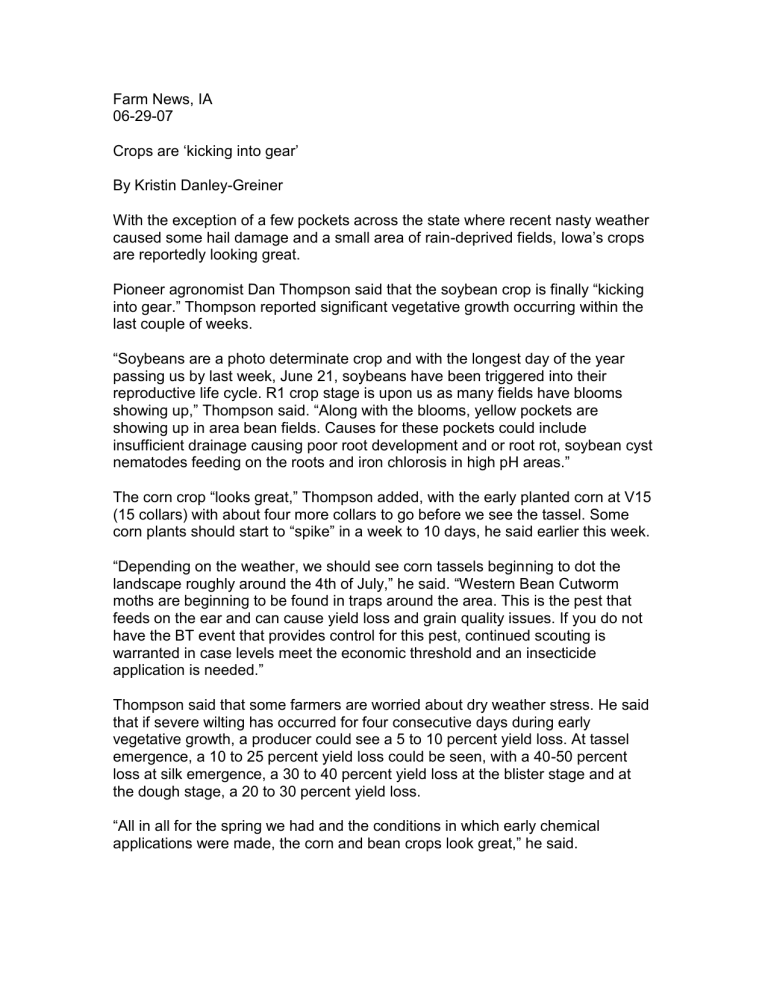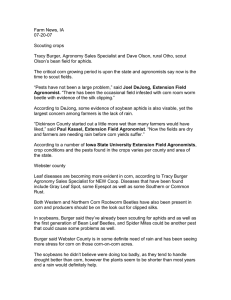Farm News, IA 06-29-07 Crops are ‘kicking into gear’

Farm News, IA
06-29-07
Crops are ‘kicking into gear’
By Kristin Danley-Greiner
With the exception of a few pockets across the state where recent nasty weather caused some hail damage and a small area of raindeprived fields, Iowa’s crops are reportedly looking great.
Pioneer agronomist Dan Thompson said that the soybean crop is finally “kicking into gear.” Thompson reported significant vegetative growth occurring within the last couple of weeks.
“Soybeans are a photo determinate crop and with the longest day of the year passing us by last week, June 21, soybeans have been triggered into their reproductive life cycle. R1 crop stage is upon us as many fields have blooms showing up,” Thompson said. “Along with the blooms, yellow pockets are showing up in area bean fields. Causes for these pockets could include insufficient drainage causing poor root development and or root rot, soybean cyst nematodes feeding on the roots and iron chlorosis in high pH areas.”
The corn crop “looks great,” Thompson added, with the early planted corn at V15
(15 collars) with about four more collars to go before we see the tassel. Some corn plants should start to “spike” in a week to 10 days, he said earlier this week.
“Depending on the weather, we should see corn tassels beginning to dot the landscape roughly around the 4th of July,” he said. “Western Bean Cutworm moths are beginning to be found in traps around the area. This is the pest that feeds on the ear and can cause yield loss and grain quality issues. If you do not have the BT event that provides control for this pest, continued scouting is warranted in case levels meet the economic threshold and an insecticide application is needed.”
Thompson said that some farmers are worried about dry weather stress. He said that if severe wilting has occurred for four consecutive days during early vegetative growth, a producer could see a 5 to 10 percent yield loss. At tassel emergence, a 10 to 25 percent yield loss could be seen, with a 40-50 percent loss at silk emergence, a 30 to 40 percent yield loss at the blister stage and at the dough stage, a 20 to 30 percent yield loss.
“All in all for the spring we had and the conditions in which early chemical applications were made, the corn and bean crops look great,” he said.
Iowa State University (ISU) Extension crops field specialist Paul Kassel , who is based out of Spencer, agreed that the crop situation continues to “look very good.”
“There will be some corn that will tassel this weekend (early corn hybrids planted early). There is a lot of corn with the tassel about two leaves away from emerging. Some hail damage reported last week in the Laurens/Ware area from a storm almost two weeks ago,” he said. “But it wasn’t a very big area.
“Soybeans look very good. No aphids, yet but you can find a lot of potato leafhoppers in soybeans,” Kassel continued. “You can find SCN in soybeans, also.”
Joel DeJong, ISU Extension crops field specialist out of LeMars , said that the corn continues to grow rapidly in most of northwestern Iowa. However, sections within a fourcounty area haven’t received much rain since early May.
“Some fields are showing the effects due to poorer root systems and low surface moisture levels. But, for the most part, corn is looking good, and is likely to start pollinati ng as early as I ever remember,” he said. “Soybeans are now blooming in most fields and are starting to grow rapidly. They look quite good, too. No really significant pest issues at this time, except maybe potato leafhoppers in alfalfa.”
Palle Pedersen, agronomist at ISU , said that the soybean crop in general is
“looking good,” despite being planted an average of two weeks late in many areas.
“There aren’t a lot of insect or disease issues to talk about,” he said. “First generation bean leaf beetles can now be found in a few fields, and a few fields have been damaged by hail. IDC can now also be seen in many fields in central and north central Iowa.”
Brian Kreutner, CCA, a member of the Iowa Soybean Association’s Crop
Scouting Network and Kirkwood College ag production management instructor, found an average three aphids per plant in a V4 maturity field in Benton County on June 16. He pulled 20 plants and found aphids on every one. Pedersen said that there have been other findings in the past week, including a few aphids found in research plots in Ames.
Common stalk borer, European corn borer and grape colaspis are beginning to show up in non-
Bt hybrids in fields enrolled in the Iowa Soybean Association’s scouting program. Other insects noted by consultants scouting the fields were stinkbug and southern corn rootworm adults.






